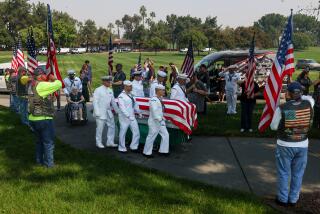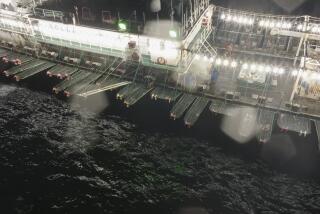W.B. Lipes, 84; Performed Historic Appendectomy Aboard Sub During WWII
- Share via
Wheeler Bryson “Johnny” Lipes, the Navy pharmacist’s mate who during World War II performed the first emergency appendectomy ever done aboard a submerged submarine, has died. He was 84.
Lipes died of pancreatic cancer Sunday in New Bern, N.C.
His historic surgery was one of the most famous lifesaving acts of the war.
“ ‘They are giving him ether now,’ was what they said back in the aft torpedo rooms. ‘He’s gone under, and they’re ready to cut him open,’ the crew whispered sitting on their pipe bunks cramped between torpedoes,” was the opening paragraph of a story by war correspondent George Weller in the Chicago Daily News on Dec. 14, 1942.
The story, picked up by other newspapers and devoured by Americans hungry for good news in the early stages of the war, earned Weller a Pulitzer Prize. Lipes, the accidental surgeon, became an instant hero and was asked to make speeches encouraging the sale of war bonds and increased industrial production.
Lipes’ operation was further memorialized in the films “Destination Tokyo” (1943) and “Run Silent, Run Deep” (1958) and in the 1950s television series about the submarine fleet, “The Silent Service.” The Navy subsequently produced its own film, “The Pharmacist’s Mate.”
In February 2005, Lipes belatedly received a Navy Commendation Medal at Camp Lejeune, N.C., for the appendectomy he performed Sept. 11, 1942, in the officers’ mess of the Seadragon, 120 feet beneath the surface of the South China Sea.
At the medal ceremony, Lipes consistently downplayed the feat, as he had for more than 60 years, saying, “I did what I had to do to save a man’s life. Darrell Rector was the brave one.”
“I’ve asked myself, ‘Would I have gotten up on that table and let someone do the same thing to me?’ ” Lipes told the Associated Press in February. “He was one of the most courageous people I’ve ever met.”
Seaman Darrell Dean Rector, then 19, was the patient. Thirteen days after Lipes operated, referring to a medical manual and holding the incision open with bent spoons sterilized in boiling water, Rector was back on duty.
The seaman died two years later with 77 others when the submarine Tang was destroyed by one of its own torpedoes.
Lipes, who had observed appendectomies but never performed any surgery, was reluctant to operate. But the commanding officer, convinced that Lipes knew more about medical procedures than any of the superior officers assembled to assist, ordered him to proceed.
The late Dr. Franz P. Hoskins, the lieutenant who anesthetized Rector -- and made the submarine’s crew woozy -- by pouring ether through gauze and a tea strainer, attended medical school after the war. He learned, he said in 1987, that “you can do an appendectomy with three ounces of ether. I used three pints on the Seadragon.”
Lipes, Hoskins, the commanding officer and two others performed the two-hour, 36-minute surgery on the officers’ bolted-down dining table.
Lipes had to hunt for the enlarged, displaced and gangrenous appendix, doubling the time an appendectomy normally takes. After removing it, he cauterized the stump with phenol, which was used on subs as an industrial cleaning solvent.
With no antibiotics available, the team remained blissfully ignorant of such potential complications as staph infection or peritonitis. Rector awoke half an hour after he was stitched up, not only healthy but hungry.
Although the public loved the story, Lipes incurred the wrath of Navy doctors for practicing medicine without a license. Some even circulated a rumor that Lipes never removed the appendix.
“One doctor physically assaulted Johnny when he got back to Australia,” Robert Bornman, a retired Navy submarine medical officer and military historian, told National Public Radio in February. “Another one told him it would’ve been better if the patient died than for a corpsman to do an abdominal operation.”
Sixty-three years after his feat, thanks to the work of Navy Medical Department historian Jan Herman, Lipes was finally honored with the Navy’s prestigious Commendation Medal for his “resourcefulness and skillful and heroic surgical intervention under highly unfavorable conditions.”
Born July 12, 1920, in Newcastle, Va., Lipes was involved in healthcare most of his life. He grew up helping his mother provide home nursing care to an officer’s wife and working in a Navy dispensary in Norfolk, Va.
Although Lipes later earned his high school diploma and graduated from George Washington University, he dropped out of high school at the height of the Depression to join the Navy at 16.
After completing hospital corpsman school in San Diego, Lipes worked as a pharmacy technician on the Texas and in 1937 transferred to the Philadelphia Naval Hospital, where he rose to pharmacist’s mate 3rd class. In 1940, he moved to Canacao Naval Hospital in the Philippines, advancing to pharmacist’s mate 1st class.
Lipes transferred to submarine duty and was assigned to the Sealion, which was sunk at Cavite Navy Yard by Japanese bombs Dec. 10, 1941. Although he received shrapnel wounds in his arms and legs, he was quickly reassigned to the Seadragon, which had survived the attack.
The sub was in its fourth combat patrol, 2,000 miles from the nearest Allied port or surgeon, when Rector developed appendicitis.
Lipes later returned to the Philadelphia Naval Hospital and in 1951 was commissioned an ensign in the Navy Medical Service Corps.
After 26 years of service, he retired from the Navy in 1962 with the rank of lieutenant commander.
He spent an additional 30 years in hospital administration in Tennessee and Texas.
Lipes is survived by his second wife, Audrey, whom he married eight years ago. Information on other survivors was not available.
More to Read
Sign up for Essential California
The most important California stories and recommendations in your inbox every morning.
You may occasionally receive promotional content from the Los Angeles Times.













